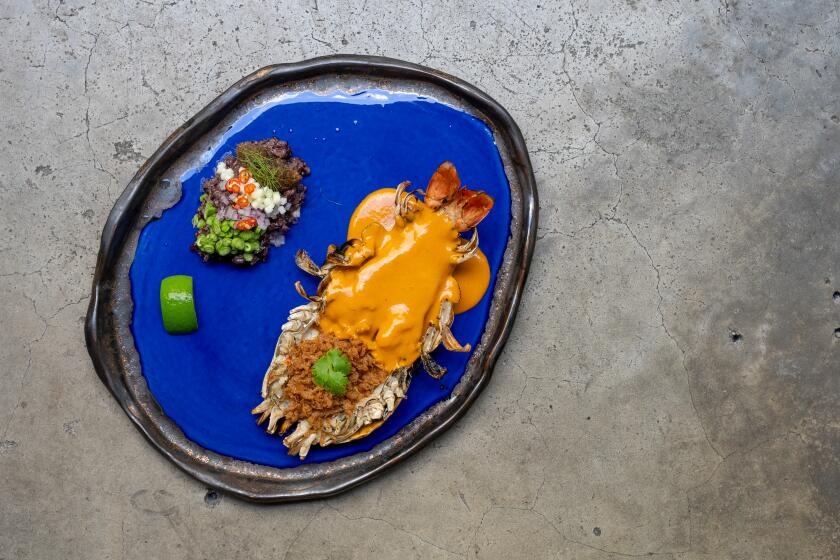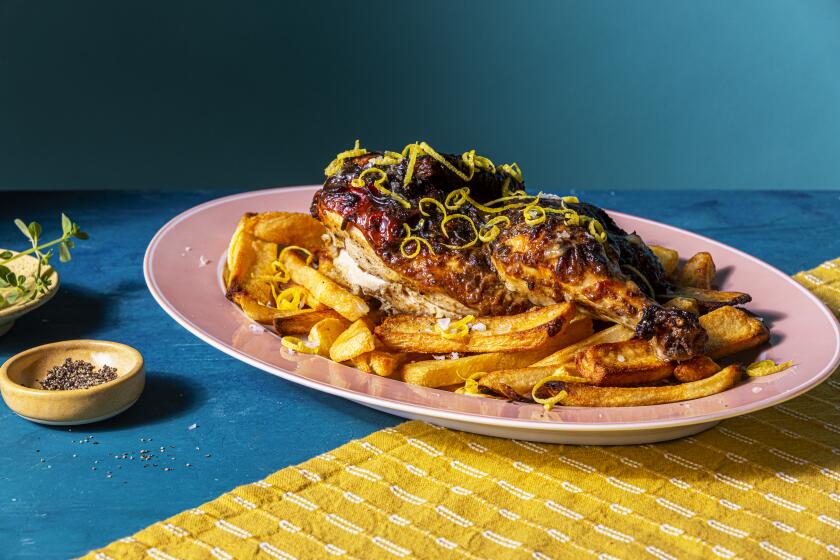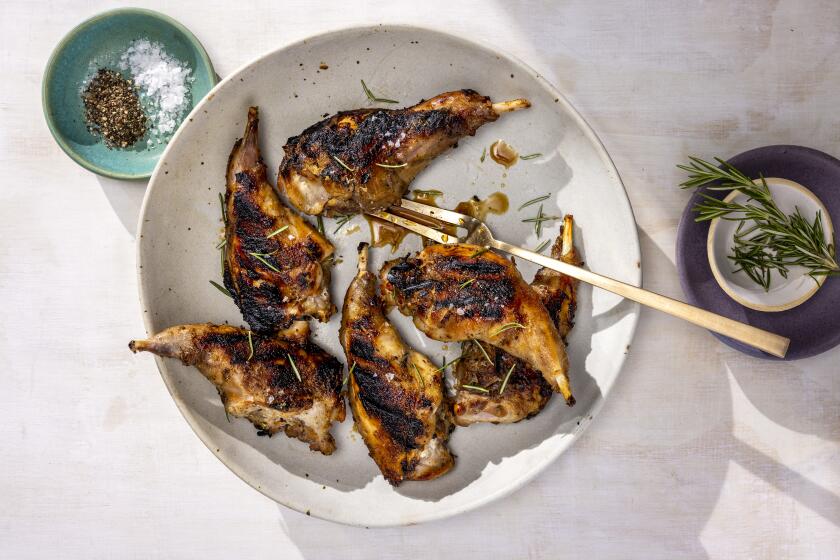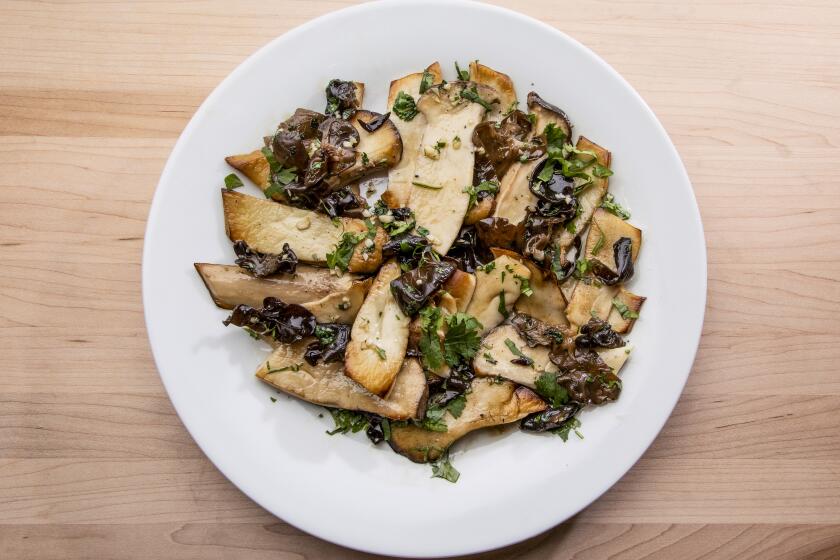Roasted Pork Loin with Yukon Gold Potatoes, Granny Smith Apples and French Prunes

A traveling chef should never be without kosher salt, a proper pepper mill and string. Though most home cooks don’t need to be told about the first two, the last might come as a surprise.
String, properly used, ensures uniformity of cooking and creates an appealing appearance. If an entire loin or roast is being cooked, string can also make carving easier. In single portions--such as a filet mignon or a chop--string helps to create a perfect plump shape and then holds the meat in that shape throughout cooking.
Finally, though this is not fine enough for a first-class kitchen, the tapered part of any cut, such as in a tenderloin, can be folded over and tied to create a perfectly cooked extra portion.
Tying meat is important because an untied roast that goes into the oven cold is slack and will firm up only when its surface temperature reaches 130 degrees or so. Of course, by then it is firming into whatever lazy shape you’ve allowed it to assume.
Furthermore, because of the unevenness of its shape, the interior will cook at different rates--one spot will be medium when another is still nearly raw. For this reason, it’s almost impossible to use a thermometer accurately on an untied roast.
The slipknot is what makes string so useful. It is a simple knot--in effect a reverse square knot--but without question it can be frustrating at first. It’s easier to do than to explain; learn from the accompanying photos.
Whatever you do, don’t try to teach yourself to tie a slipknot five minutes before the guests arrive or you’ll throw your bolt of butchers’ string through the window and never touch it again. This is something to practice on a weekend afternoon. And if it’s not fun to learn, don’t do it at all; have your butcher tie the roast for you.
It might sound odd, but once mastered, tying slipknots is hugely satisfying. Tied roasts and racks look beautiful when properly seasoned with plenty of salt and pepper and sprigs of thyme before being slipped into a hot oven. They become especially pleasurable to cook because you know they’ll be perfectly done all the way through. And then comes the pleasure of serving because the roast is so easy to carve.
All this from one little knot. But good cooking is not about digging in to a perfect finished dish at the dinner table. Good cooking is about taking pleasure in all those small moments of work that add up to the perfect execution of that dish.
A few points to note:
* Use cotton butchers’ string, which can be found wherever professional culinary equipment is sold; it can also be ordered from your butcher. You can use other cotton string or jute twine in a desperate moment, but those tend to be hard, stiff and difficult to work with, and they can be thin enough to cut into the flesh; butchers’ twine is soft and it’s the perfect thickness. Obviously, don’t use plastic string, which could melt.
* Tie snugly but not too tightly. The string should never dig into the flesh of what’s being tied. This is especially important when working with fish.
* Always remove the string before serving; with single portions, it’s easy to forget.
* Keep your string out on the counter for other uses as well, such as tying cheesecloth and tying sachets of herbs and bouquet garni for easy removal after they’ve flavored the pot.
* Rub pork loin with cinnamon and season liberally with salt and pepper.
* Heat oil in heavy roasting pan over moderate heat until oil begins to smoke. Sear pork loin on all sides until brown. Remove from roaster and drain excess fat.
* Add potatoes and rosemary to roasting pan. Place pork loin on top. Add stock and butter. Roast in 325-degree oven, basting every 15 minutes. After 45 minutes add apples and prunes. Continue roasting, basting every 15 minutes, until thermometer inserted in center of loin reads 150 degrees, approximately 20 to 30 minutes more.
* Remove from oven and cover loosely with foil. Let pork loin rest 15 minutes. While pork is resting, arrange potatoes, apples and prunes around serving platter.
* Strain cooking liquid into saucepan and bring to simmer. Slice pork loin and place slices on top of potatoes, apples and prunes. Add parsley to hot sauce and spoon over pork.
“The French Laundry Cookbook” by Thomas Keller and Michael Ruhlman is “Cookbook of the Year.”
Rub pork loin with cinnamon and season liberally with salt and pepper.
Heat oil in heavy roasting pan over moderate heat until oil begins to smoke. Sear pork loin on all sides until brown. Remove from roaster and drain excess fat.
Add potatoes and rosemary to roasting pan. Place pork loin on top. Add stock and butter. Roast in 325-degree oven, basting every 15 minutes. After 45 minutes add apples and prunes. Continue roasting, basting every 15 minutes, until thermometer inserted in center of loin reads 150 degrees, approximately 20 to 30 minutes more.
Remove from oven and cover loosely with foil. Let pork loin rest 15 minutes. While pork is resting, arrange potatoes, apples and prunes around serving platter.
Strain cooking liquid into saucepan and bring to simmer. Slice pork loin and place slices on top of potatoes, apples and prunes. Add parsley to hot sauce and spoon over pork.
Get our Cooking newsletter.
Your roundup of inspiring recipes and kitchen tricks.
You may occasionally receive promotional content from the Los Angeles Times.















